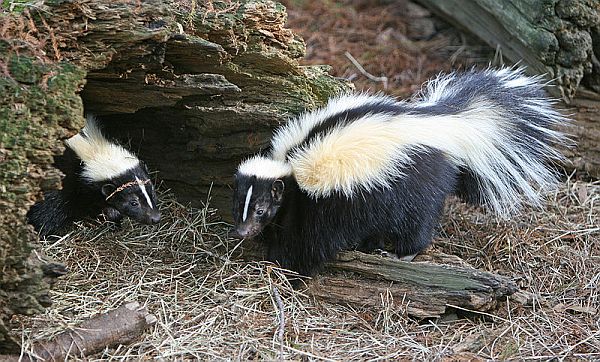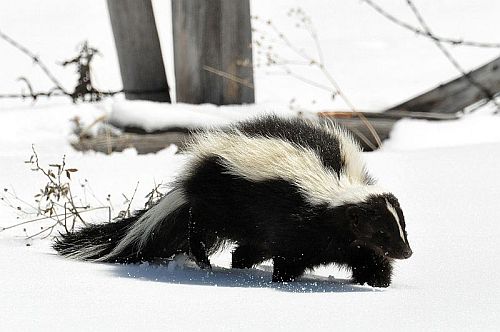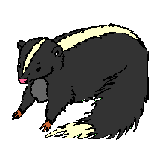Where the skunk lives
The skunk can be found in southern parts of Canada.
It likes to live along the edge of the forest, in bushy areas
or on the grassy prairies.
Sometimes the skunk will dig its own den,
but it may move into another mammal's den.
Skunks also live under old buildings or rock piles,
or in hollow tree stumps.
The skunk uses dried leaves and grass to line the den.
In the winter it may form a ball of grass and place it at the door of the den
to keep out the cold wind.

photo: Tom Friedel;
wikipedia; Creative Commons License
Attribution 3.0 Unported (CC BY 3.0)
Appearance
The striped skunk has a black coat with two white stripes down the back
and one white stripe up the forehead. The stripes are a warning to other
animals to stay away.
It is the size of a house cat.
A skunk's eyes and ears are small.
It can not see well but its sense of hearing is good.
The skunk has strong front legs and sharp claws that are good for digging a den.
Food
During the day, a skunk sleeps. It hunts at night, walking slowly along,
catching insects and looking for small fruit.
It sniffs out meadow mice, gophers, moles, squirrels and chipmunks.
Protection
The skunk has musk glands and can shoot a liquid that has an awful odor.
First, it gives a warning when something approaches.
It stiffens its legs,
stamps the ground with its feet, snaps its teeth, and its hairs stand up.
Then the skunk swings its rear end around, lifts its tail up
out of the way
and shoots. Out comes a terrible-smelling yellow mist.
The spray can go as far as four meters.
Enemies
When a badger, coyote, bobcat, fox, eagle or large owl is hungry enough,
it will attack the skunk.
Babies
The female may have four to eight babies (kits) in late April or
early May. The babies are skinny, blind, hairless and
without teeth. In three weeks their eyes are open. In six weeks
their fur is fully grown.
In two months they are no longer fed the mother's milk.
The mother skunk takes them out to hunt with her at night.

Adaptation
In the fall the skunk eats alot and grows a thick coat.
The mothers and kits move into large dens and
snuggle together to keep warm. During the winter the skunk sleeps
and lives off of the stored body fat.
It does not hibernate. It wakes up often and may leave the den
to search for small animals, berries or seeds to eat.
 source: Flickr :
D.Dzurisin ;
Creative Commons License
Attribution 2.0 Generic (CC BY 2.0)
source: Flickr :
D.Dzurisin ;
Creative Commons License
Attribution 2.0 Generic (CC BY 2.0)
other interesting facts
- A young skunk makes a good pet if the musk glands are removed.
- The terrible-smelling liquid is called mercaptan.
- The skunk's spray burns the eyes and the nose.
- The skunk makes enough liquid for five sprays a week.
- It helps the farmer by eating insects and rodents that destroy crops.

CANADIAN ANIMALS
|

